Master of Orion II
Rules of Engagement 2
Syndicate
Alien Legacy
Buzz Aldrin's Race into Space
 Master of Orion II (1996): This one actually doesn’t really fall into the “nobody remembers it” category, but the recent sequel Master of Orion 3 was terrible, so I’m just going to include MOOII on this list anyway. The original Master of Orion is the closest thing we’ve ever seen to “Civilization in Space.” It was a masterpiece of design, having a simple yet deep interface and giving the user amazing flexibility in their actions. You could, for example, build giant fleets of custom-designed starships (including Death Star-like planet busters) or a network of stargates for your smaller yet more powerful ships (or both). It also had a compelling sci-fi storyline, the best enemy AI there ever was in a strategy game until Alpha Centauri in 1999, and amazingly fun turn-based-but-it-felt-like-real-time starfleet combat. [Quick side lesson to the modern game developers who feel a compulsive need to produce hard-drive-sucking multi-gigabyte games: MOO crammed gameplay that is still fresh and current 13 years later onto three 3.5” 1.44 MB floppy disks, for a total size of about 7 MBs.]
Master of Orion II (1996): This one actually doesn’t really fall into the “nobody remembers it” category, but the recent sequel Master of Orion 3 was terrible, so I’m just going to include MOOII on this list anyway. The original Master of Orion is the closest thing we’ve ever seen to “Civilization in Space.” It was a masterpiece of design, having a simple yet deep interface and giving the user amazing flexibility in their actions. You could, for example, build giant fleets of custom-designed starships (including Death Star-like planet busters) or a network of stargates for your smaller yet more powerful ships (or both). It also had a compelling sci-fi storyline, the best enemy AI there ever was in a strategy game until Alpha Centauri in 1999, and amazingly fun turn-based-but-it-felt-like-real-time starfleet combat. [Quick side lesson to the modern game developers who feel a compulsive need to produce hard-drive-sucking multi-gigabyte games: MOO crammed gameplay that is still fresh and current 13 years later onto three 3.5” 1.44 MB floppy disks, for a total size of about 7 MBs.]The original MOO was hugely fun to play and was therefore a big success. Unusually, the original development team was brought back and given a chance to make a sequel to a game that was already considered a classic. The results were astounding. The designers radically expanded every facet of the game. You now had complete multi-planet star systems to colonize. You could drop research stations onto airless moons or terraform molten worlds. There were almost twice as many alien races, a dizzying array of custom starship choices, heroes to recruit and use as colony governors and military commanders, an enhanced diplomacy screen, ground combat, build queues, a revamped and improved fleet battle interface, a new diplomacy interface, a humongous tech tree seriously larger than the tech tree in the first game, more alien artifacts, and the addition of the Borg-like Antarans in order to spice up the gameplay—all done with LAN support in high-res SVGA graphics. In short, no turn-based strategy game before or since has offered more strategic options to the player in such a fun and playable package, although Alpha Centauri comes very, very close.
Although considered a classic today, by my recollection Master of Orion II wasn’t as well-received as its predecessor at the time. It was the follow-up to a beloved classic, which is always a tough act to follow, and most of the criticisms directed at the game had to do with the fact that the immensely deep and complex MOO II was the opposite of MOO. It was also released in-between Civilization II and Alpha Centauri, and was overshadowed to some extent by those two legendary computer games. I’ve played both MOO games extensively and they both have a different feel. The first game is slightly more fun, but the second is more satisfying, and provides all of the strategic options you have in modern games like SMAC or Civ IV. MOO II is still the best space-conquest game ever produced (it’s way better than the much-lauded Galactic Civilizations). Because it runs very well in Windows XP, it still occupies space on my hard drive, 10 years later.
 Rules of Engagement 2 (1993): The last game to come out of Impressions before its purchase by Sierra, this game was described by Compute Magazine as the first “Space Opera Simulator”. Clearly inspired by Star Trek (right down to an interface that strongly resembled the famous TNG LCARS look), this game put you in tactical command of a starship. Gameplay consisted of set-piece tactical engagements between you (or you and your fleet) and adversary forces, such as aliens or rebels. You generated your own Captain and worked your way up the ranks. You could also design your own starship and configure your fleet. You had to maneuver your starship (in two dimensions…just like Star Trek), launch weapons, land security crews, execute repairs, and coordinate fleet movements on the fly using the nifty four-panel interface. Commanding the starship was a lot of fun; you had all sorts of windows that you could bring up, each with deep functions and commands. ROE 2 was also designed to interface with a second game called Breach 3, so when you sent a boarding party to an alien spaceship, Breach 3 would load up and you could control your troopers in real time--cool.
Rules of Engagement 2 (1993): The last game to come out of Impressions before its purchase by Sierra, this game was described by Compute Magazine as the first “Space Opera Simulator”. Clearly inspired by Star Trek (right down to an interface that strongly resembled the famous TNG LCARS look), this game put you in tactical command of a starship. Gameplay consisted of set-piece tactical engagements between you (or you and your fleet) and adversary forces, such as aliens or rebels. You generated your own Captain and worked your way up the ranks. You could also design your own starship and configure your fleet. You had to maneuver your starship (in two dimensions…just like Star Trek), launch weapons, land security crews, execute repairs, and coordinate fleet movements on the fly using the nifty four-panel interface. Commanding the starship was a lot of fun; you had all sorts of windows that you could bring up, each with deep functions and commands. ROE 2 was also designed to interface with a second game called Breach 3, so when you sent a boarding party to an alien spaceship, Breach 3 would load up and you could control your troopers in real time--cool. RoE 2 is not remembered today for many reasons. First, (like the modern Starfleet Command series), it was too “realistic” to the detriment of fun. On Star Trek, no matter how dire the situation is, you can always count on Data or Geordi to save the day. Not so in RoE 2. Engagements could be frustrating, because as the Captain you had to keep track of a lot of things simultaneously. Without Scotty fixing his wee bairns or Sulu at the helm, more often or not your ship would go down in flames. Keyboard-mashing frustration, you say? Yep. Second, the designers put in a lot of work creating a rich science-fiction setting for the game but didn’t properly exploit it--the game shipped with only a handful of campaigns and a campaign editor. You were supposed to use it to “expand your own adventures.” For 1993, the campaign editor was astounding. You had branching storylines, animations, plots, briefing movies-you could do it all. Too bad the designers didn’t use their own creation more effectively—the campaigns were short and ramped up in difficulty quickly, and making your own was too much work. Frustrating, you say? You betcha. Still, complaints aside, ROE2 was an amazing achievement. Too bad they never got a chance to make a full-blown sequel.
RoE 2 is not remembered today for many reasons. First, (like the modern Starfleet Command series), it was too “realistic” to the detriment of fun. On Star Trek, no matter how dire the situation is, you can always count on Data or Geordi to save the day. Not so in RoE 2. Engagements could be frustrating, because as the Captain you had to keep track of a lot of things simultaneously. Without Scotty fixing his wee bairns or Sulu at the helm, more often or not your ship would go down in flames. Keyboard-mashing frustration, you say? Yep. Second, the designers put in a lot of work creating a rich science-fiction setting for the game but didn’t properly exploit it--the game shipped with only a handful of campaigns and a campaign editor. You were supposed to use it to “expand your own adventures.” For 1993, the campaign editor was astounding. You had branching storylines, animations, plots, briefing movies-you could do it all. Too bad the designers didn’t use their own creation more effectively—the campaigns were short and ramped up in difficulty quickly, and making your own was too much work. Frustrating, you say? You betcha. Still, complaints aside, ROE2 was an amazing achievement. Too bad they never got a chance to make a full-blown sequel.  Syndicate (1994): Way back in ye Olde Tymes before the Internet, you received news of upcoming computer games by flipping through Computer Gaming World. Or, more precisely, looking at the print advertisements in Computer Gaming World—the only source of information about what games were coming out. The ad for Syndicate was a two-page spread with a CG-rendered picture of a giant skyscraper and a blimp, a row of pictures at the bottom depicting small arms, and copy which said something like “It’s the future! Lead a four-man team of commandos on dangerous missions!” (Quick side note: Syndicate had the Biggest Box Ever, even for a DOS game—it was almost 3 and a half inches thick!!) Based solely on the ad which looked interesting, and the screenshots on the back of the box, I picked it up, expecting a game about near-future anti-terrorist special-ops. Such was how computer game purchases were decided in the Olde Tymes.
Syndicate (1994): Way back in ye Olde Tymes before the Internet, you received news of upcoming computer games by flipping through Computer Gaming World. Or, more precisely, looking at the print advertisements in Computer Gaming World—the only source of information about what games were coming out. The ad for Syndicate was a two-page spread with a CG-rendered picture of a giant skyscraper and a blimp, a row of pictures at the bottom depicting small arms, and copy which said something like “It’s the future! Lead a four-man team of commandos on dangerous missions!” (Quick side note: Syndicate had the Biggest Box Ever, even for a DOS game—it was almost 3 and a half inches thick!!) Based solely on the ad which looked interesting, and the screenshots on the back of the box, I picked it up, expecting a game about near-future anti-terrorist special-ops. Such was how computer game purchases were decided in the Olde Tymes.Buying a game without foreknowledge of
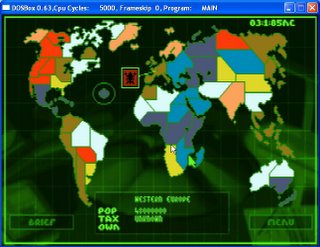 content or detailed review in hand? In this case, we got really lucky. Syndicate was an incredibly good computer game. Set in a dystopic future clearly inspired by Blade Runner, you played the executive in charge of a small corporation (hence the name Syndicate). You had to equip a four-man team of cyborg commandos with weapons and equipment then use that team to complete missions designed to help your corporation become the dominant force on the planet. The missions would take place real-time in an incredibly detailed 3-D world, complete with moving vehicles, homes, businesses, and civilian bystanders—all of
content or detailed review in hand? In this case, we got really lucky. Syndicate was an incredibly good computer game. Set in a dystopic future clearly inspired by Blade Runner, you played the executive in charge of a small corporation (hence the name Syndicate). You had to equip a four-man team of cyborg commandos with weapons and equipment then use that team to complete missions designed to help your corporation become the dominant force on the planet. The missions would take place real-time in an incredibly detailed 3-D world, complete with moving vehicles, homes, businesses, and civilian bystanders—all of which could be destroyed by your actions. The best part of the game was the complete freedom it offered. You could interact with this world in ways that surpass modern games, such as hopping into any vehicle (and I do mean any, from tanks to police cars to fire engines to trucks), knocking down walls or other objects, and hiding in the shadows. You could take weapons from downed opponents and use them. As long as the mission goals were met, you could literally use any means you desired to achieve your objectives, from stealth infiltration to missile launchers. As you completed missions you acquired more territory, which gave you more income, and thus better equipment. You could even choose the missions that you wanted on a RISK-style strategic map. It was great fun. This game was hailed as a classic immediately upon release, but because it predated the Internet (and was followed by an inferior sequel) it has dropped off the radar—which is a shame. The fact that a 10 megabyte game from 13 years ago offered more interactivity with your environment than even Half-life 2 is pretty sad, when you think about it.
which could be destroyed by your actions. The best part of the game was the complete freedom it offered. You could interact with this world in ways that surpass modern games, such as hopping into any vehicle (and I do mean any, from tanks to police cars to fire engines to trucks), knocking down walls or other objects, and hiding in the shadows. You could take weapons from downed opponents and use them. As long as the mission goals were met, you could literally use any means you desired to achieve your objectives, from stealth infiltration to missile launchers. As you completed missions you acquired more territory, which gave you more income, and thus better equipment. You could even choose the missions that you wanted on a RISK-style strategic map. It was great fun. This game was hailed as a classic immediately upon release, but because it predated the Internet (and was followed by an inferior sequel) it has dropped off the radar—which is a shame. The fact that a 10 megabyte game from 13 years ago offered more interactivity with your environment than even Half-life 2 is pretty sad, when you think about it.  Alien Legacy (1994): This game was released by Sierra the same year as the legendarily awful Outpost, which was also released by Sierra. Unlike Outpost, Alien Legacy was actually good. It was set in the late 21st century, at a time when the United Earth forces are at war with a brutal alien race. You played the role of the Captain of a Bussard Ramjet starship sent to Beta Caeli star system in order to preserve the human race. Although you were supposed to be the second ship to arrive, something mysterious happened to the first ship after arrival, so now you have to not only unravel the mystery but successfully colonize the star system. As the Captain, you interact with and give
Alien Legacy (1994): This game was released by Sierra the same year as the legendarily awful Outpost, which was also released by Sierra. Unlike Outpost, Alien Legacy was actually good. It was set in the late 21st century, at a time when the United Earth forces are at war with a brutal alien race. You played the role of the Captain of a Bussard Ramjet starship sent to Beta Caeli star system in order to preserve the human race. Although you were supposed to be the second ship to arrive, something mysterious happened to the first ship after arrival, so now you have to not only unravel the mystery but successfully colonize the star system. As the Captain, you interact with and give 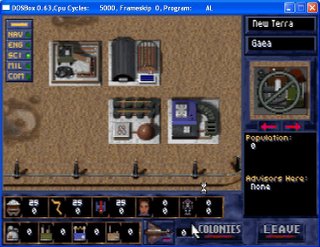 orders to the well-characterized officers of your starship, who help you to set up your colonies and report on happenings within the Beta Caeli star system. Because of strong writing and voice acting, you really felt like you were the leader interacting with actual officers of a starship. The coolest part of the game was the strategic view, which consisted of a nifty real-time view of the Beta Caeli system showing all the planets. You could rotate and zoom around the system, checking on the location of your ships, space stations, and surface colonies. You would click on the planets to bring up the planet view, where you would control your colonies and select which structures to build on the surface. You could also set up asteroid mining stations, space habitats, and gas-giant hydrogen extraction facilities. Actually, to date, this game is the best depiction of realistic solar system colonization that has ever been attempted, which is also kind of sad when you think
orders to the well-characterized officers of your starship, who help you to set up your colonies and report on happenings within the Beta Caeli star system. Because of strong writing and voice acting, you really felt like you were the leader interacting with actual officers of a starship. The coolest part of the game was the strategic view, which consisted of a nifty real-time view of the Beta Caeli system showing all the planets. You could rotate and zoom around the system, checking on the location of your ships, space stations, and surface colonies. You would click on the planets to bring up the planet view, where you would control your colonies and select which structures to build on the surface. You could also set up asteroid mining stations, space habitats, and gas-giant hydrogen extraction facilities. Actually, to date, this game is the best depiction of realistic solar system colonization that has ever been attempted, which is also kind of sad when you think  about it. A big part of the game was exploration; you had to fly scoutships around the planet looking for resources, alien artifacts, and clues to the fate of the previous expedition in a manner very similar to both Starflight and Star Control II—not surprising, since some of the same designers worked on Alien Legacy. This combination of strong writing, an excellent sci-fi setting, an intriguing mystery, Civ-style colony building, engaging exploration, and strategic decision-making meant that Alien Legacy was incredibly fun to play. This was a really good game, but because Sierra spent so much money promoting the unmitigated disaster that was Outpost instead it didn’t sell very well.
about it. A big part of the game was exploration; you had to fly scoutships around the planet looking for resources, alien artifacts, and clues to the fate of the previous expedition in a manner very similar to both Starflight and Star Control II—not surprising, since some of the same designers worked on Alien Legacy. This combination of strong writing, an excellent sci-fi setting, an intriguing mystery, Civ-style colony building, engaging exploration, and strategic decision-making meant that Alien Legacy was incredibly fun to play. This was a really good game, but because Sierra spent so much money promoting the unmitigated disaster that was Outpost instead it didn’t sell very well.Buzz Aldrin’s Race Into Space (Disk version in 1992; CD-ROM in 1994): This one is on my all-time top five list. It is hands down the most innovative strategy game that I have ever played. This game was incredibly addictive. It put you in the role as the Administrator of NASA or the Chief Designer of the Energia Bureau, charged with putting the first humans on Earth’s Moon. You had to select astronauts, choose rockets, research new technologies, build ground facilities, and then schedule and fly missions to achieve this goal, all while staying under budget. You
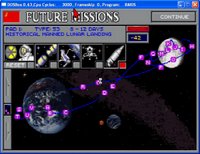 had a virtually limitless supply of options at your disposal, which is what made this game so appealing. Not happy with NASA’s dead-end Apollo strategy? Well, try modifying a Gemini spacecraft for lunar operations to use Earth Orbital Rendevous instead and see how it goes. Russians getting ahead? Start flying lunar missions in 1967, but at higher cost with less safety margins. The more successes you had, the higher your budgets got, which allowed you to fly more missions with better hardware. The US and the Soviets would alternate turns, and after your turn was complete, you’d watch the missions that you had scheduled unfold in glorious SVGA graphics with sound. Obviously, the first team on the Moon won the game!
had a virtually limitless supply of options at your disposal, which is what made this game so appealing. Not happy with NASA’s dead-end Apollo strategy? Well, try modifying a Gemini spacecraft for lunar operations to use Earth Orbital Rendevous instead and see how it goes. Russians getting ahead? Start flying lunar missions in 1967, but at higher cost with less safety margins. The more successes you had, the higher your budgets got, which allowed you to fly more missions with better hardware. The US and the Soviets would alternate turns, and after your turn was complete, you’d watch the missions that you had scheduled unfold in glorious SVGA graphics with sound. Obviously, the first team on the Moon won the game!Running the space program makes
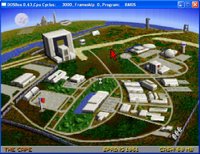 a darn good and fun computer game. It was really satisfying to watch your missions unfold. The best part was seeing the “What if” scenarios play out, because the designers put a lot of effort into creating animations using stock footage to simulate events that never actually happened, such as the launch of the gargantuan Nova rocket. At the time, the multimedia aspect of this game were nothing sort of astonishing; this was the first game I played using a Sound Blaster (as opposed to a PC speaker) and it was a great showcase for the then-new soundcard technology. The interface was a snap, and managing all the various aspects of the space race was a heckuva lot of fun. You could even do two-player hotseat matches with a friend, taking turns at playing space-program manager.
a darn good and fun computer game. It was really satisfying to watch your missions unfold. The best part was seeing the “What if” scenarios play out, because the designers put a lot of effort into creating animations using stock footage to simulate events that never actually happened, such as the launch of the gargantuan Nova rocket. At the time, the multimedia aspect of this game were nothing sort of astonishing; this was the first game I played using a Sound Blaster (as opposed to a PC speaker) and it was a great showcase for the then-new soundcard technology. The interface was a snap, and managing all the various aspects of the space race was a heckuva lot of fun. You could even do two-player hotseat matches with a friend, taking turns at playing space-program manager.So, what went wrong? Well, unfortunately, succeeding in the first
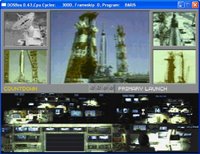
disk-based version of the game was really hard. The success or failure of your missions was determined by a vicious random-number generator. You had to research and flight test hardware in order to bring its “Safety Factor” (i.e., chance of not blowing up) in order to fly missions safely. Unfortunately, your missions would always blow up. Even if the “Safety Factor” was 98%, the computer’s random number generator would find that 2% chance of a catastrophic failure. During one memorable two-player game, a friend and I got so frustrated that we gave up and decided to have a “Most Catastrophic Failures” contest. Horrible, I know, but man, it was frustrating to watch your rockets blow up every time. Although everyone agreed it was an excellent game, the disk version was just too hard. Interplay released an updated CD-ROM version two years later with a relaxed random number generator, which was significantly more fun and had better graphics. By then it was unfortunately too late.
 This is a style of game that I hope somebody does again. With the new Vision for Space Exploration, interest in the Moon and the acknowledgement of the vital importance of space settlement for America's future is rising. I think that a near-term Space Colonization game, like BARIS but featuring better graphics (and not limited to the Space Race) would not only be a whole lot of fun, but spread the whole space settlement meme to a whole new generation. You could pick mission types, fight with Congress-I think it would be darn better than “SeaWorld Tycoon 5”. Maxis’ simMars game looked very promising in this regard, but unfortunately was canceled. Reportedly, a group of programmers has begun an Ur-Quan Masters-style port of the game to Windows XP, so hopefully more people will get a chance to try this timeless classic.
This is a style of game that I hope somebody does again. With the new Vision for Space Exploration, interest in the Moon and the acknowledgement of the vital importance of space settlement for America's future is rising. I think that a near-term Space Colonization game, like BARIS but featuring better graphics (and not limited to the Space Race) would not only be a whole lot of fun, but spread the whole space settlement meme to a whole new generation. You could pick mission types, fight with Congress-I think it would be darn better than “SeaWorld Tycoon 5”. Maxis’ simMars game looked very promising in this regard, but unfortunately was canceled. Reportedly, a group of programmers has begun an Ur-Quan Masters-style port of the game to Windows XP, so hopefully more people will get a chance to try this timeless classic.





"All of these gems would make commercially viable products if remade properly for modern Windows systems (hint, hint)."
ReplyDeleteHave you heard of Sword of the Stars? Looks like a new modern Moo1 for me:
http://www.kerberos-productions.com/sots.shtml
"MOO II is still the best space-conquest game ever produced (it’s way better than the much-lauded Galactic Civilizations). Because it runs very well in Windows XP, it still occupies space on my hard drive, 10 years later."
After moo3 (ACK!) I reinstalled this game....and I played it very often online...MP. There is still a fine small community around the 1.4 fan patch which includes nice mod options:
http://www.spheriumnorth.com/orion-forum/nfphpbb/
There's also an open source effort (a la freeCiv) to create a 4X space game called freeOrion.
ReplyDeleteYes, I heard about fo. IIRC they decided long time ago to pool the productions points on empire level. That's simply strange. I heard many moo fans lost interest because of this. This includes me.
ReplyDeleteI'm looking for the name of an older pc game that was out around the same time as syndicate. It was a top-down game that involved space exploration, trading and space dogfights. You started off with a star trek look-a-like shuttle craft and some of the names of the planets came from popular sci-fi culture ie. dune. Anyone have any idea what this was?
ReplyDelete